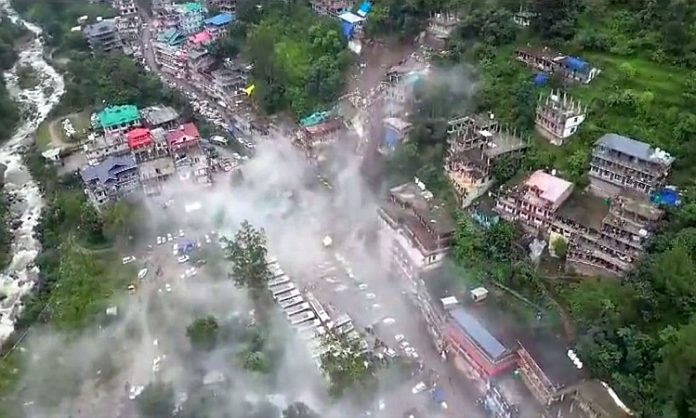Kullu (Himachal Pradesh): Several houses were flattened in Kullu district of Himachal Pradesh on Thursday following rain-induced landslide. Visuals of the landslide show many multi-storeyed buildings collapsing, leaving behind a massive trail of dust and debris.
Teams of National Disaster Response Force (NDRF) and the State Disaster Response Force (SDRF) have been deployed to rescue those feared trapped in the landslide. However, a senior police officer of Himachal Pradesh said that there might be no loss of life as the buildings were vacated prior to the landslide as a precautionary measure in the area.
Also Read: Traffic blocked on NH-5 at Shimla and Kinnaur due to landslides
Several parts of the state continued to receive unrelenting rains, leaving residents to suffer the brunt of the severe weather conditions. Hundreds of vehicles were stranded on the damaged Kullu-Mandi Highway today after heavy rainfall in the district. “The road connecting Kullu and Mandi has been damaged. An alternative route via Pandoh has also been damaged. Hence, the movement of traffic is suspended for now,” a senior Kullu police officer said.
The Indian Meteorological Department (IMD), meanwhile, issued a red alert, warning of imminent heavy to very heavy rainfall in Himachal Pradesh for the next two days starting today.
Also Read: Mandi-Kullu NH blocked, as incessant rains causes flash flood
“Disturbing visuals emerge from Anni, Kullu, depicting a massive commercial building collapsing amidst a devastating landslide. It’s noteworthy that the administration had identified the risk and successfully evacuated the building two days prior,” Himachal Pradesh Chief Minister Sukhvinder Singh Sukhu wrote on X, formerly known as Twitter.
Rains caused widespread devastation
The incessant rainfall has caused widespread devastation, with landslides, cloudbursts, and flash floods in the ecologically sensitive hill state. The state government had earlier declared the entire state “a natural calamity-affected area” and is working to assess the damage and provide relief to the affected people.
Also Read: Rain wreaks havoc in North Sikkim, tourists’ entry restricted
A total of 709 roads have been closed due to three major spells of heavy rain this monsoon season. A senior government officer said that the state had suffered damages to public infrastructure worth over ₹ 8,000 crore since June 24, when the monsoon arrived in the state.
2,022 houses flattened, 9,615 partly damaged
According to state government data, 2,022 houses have been fully damaged and 9,615 partially damaged due to the unprecedented rain. The state has also reported 113 landslides, which have caused extensive damage to infrastructure and displaced thousands of people.
Rains, related accidents claim 341 lives in HP
The rains have claimed the lives of 224 people, with another 117 killed in rain-related accidents, a government bulletin said.
Monsoon trough positioning wreak havoc
In the second week of August, the monsoon trough moved north of its normal position to the Himalayan foothills, triggering heavy rainfall, landslides, and flash floods that damaged buildings, bridges, roads, and other infrastructure in the hill states of Himachal Pradesh and Uttarakhand.
Also Read: Monsoon rains lash Delhi, Mumbai simultaneously, 1st since 1961
An interaction between a western disturbance and the trough also led to extremely heavy rainfall in the region and caused widespread damage in July. On August 18 and 19, the trough temporarily moved southward before moving to the north of its normal position again. Whenever it shifts north, rainfall is concentrated over the Himalayan states and northeast India while the rest of the plains remain largely dry.
Incessant rains lead to landslides
Continuous rainfall soaks the topsoil, leading to flash floods, heavy erosion, and collapse of structures. The soil in parts of Himachal and Uttarakhand is almost sinking and causing devastation in the geologically sensitive regions. Continued rainfall can saturate already withered topsoil and lead to small and large landslides and destruction particularly when infrastructure is not scientifically planned.
Wadia Institute of Himalayan Geology (Dehradun) director Kalachand Sain called for the need to understand why this is happening. “The monsoon trough is very active over the Himalayas. There is often also a confluence or interaction with westerly disturbances which accentuates rainfall. Due to climate change, some high-altitude regions are recording significant rises in temperatures and hence a rise in the water-vapour holding capacity. There is a lot of moisture available.”
All kinds of anthropogenic acts can’t be allowed: Expert
Sain said all kinds of anthropogenic activities cannot be allowed in the Himalayan region. “This should be clear to people. Second, we can develop a landslide vulnerability map to identify zones at the highest risk…land use maps should be prepared for them. Land use can allow only those structures which are safe,” he said.
Also Read: Centre sets up expert committee to look into Khooni Nallah tunnel in Kashmir
Elaborating, he further said that the Himalayas are a very young mountain range and a lot of subsurface and surface activities were going on there. “There is erosion going on due to heavy rainfall events and snowfall. There is exhumation of rocks and plate tectonics. It is geo-dynamically extremely active due to these ongoing processes,” he added.
Dynamites, invasive construction bane for landslides
Pushpendra Johari, senior vice-president (sustainability) at RMSI, a global disaster risk management firm, said there has been excessive rainfall but this is not the first time that the Himalayan states are getting it. He added the use of dynamite and other invasive construction activities have also impacted the topsoil. “There is no subsidence in these states on a large scale. So, every time there is heavy rain, multiple landslides are triggered. This is the case in Shimla, too, where the number of constructions is extremely high. Slope stabilisation has been completely ignored by road construction projects.”
Also Read: NH-5 subsides near Theog due to rains, traffic restored partly
Johari said slopes have not been stabilised. “It should be made mandatory for project proponents and construction companies to stabilise slopes, and ensure green cover before leaving a finished project. Secondly, the foundations of buildings and homes have to be deeper. We are seeing the topsoil just washing away with the building structure in Himachal Pradesh.”
Reckless construction activities worsened the scenario
Climate experts say that the standard precipitation index, which reflects soil moisture and rainfall conditions for a particular location, for Mandi, Shimla, Sirmaur, and Solan in Himachal and Uttarakhand’s Haridwar, Dehradun, and Chamoli are “very wet” in August as per India Meteorological Department. It can also help identify districts facing intense rainfall.
Environmentalist Ravi Chopra, who headed the Supreme Court-appointed committee on Char Dham roads’ projects, in July highlighted the significant impact of roads, railways, and transmission lines on Himalayan ecology during a meeting on the Forest Conservation (Amendment) Bill.
“We have seen how the government ensured that the Char Dham project bypassed the environment impact assessment. …an adverse impact could have been avoided had the project been scrutinised. For example, a lot of landslides took place in the Tankapur to Pithoragarh stretch. There were 102 sensitive zones and 45 landslides had already taken place in 2019,” he added.
Temperature of Himachal & Uttarakhand rose by 1°C
The impact of climate change on the temperature in Himachal Pradesh and Uttarakhand is also significant with over 1°C warming compared to the long-term average. Himachal Pradesh’s average annual mean land surface air temperature during 2022 was 1.2 °C warmer than its long-period average for the period 1981-2010.
Disturbing visuals emerge from Anni, Kullu, depicting a massive commercial building collapsing amidst a devastating landslide.
It's noteworthy that the administration had identified the risk and successfully evacuated the building two days prior. pic.twitter.com/cGAf0pPtGd
— Sukhvinder Singh Sukhu (@SukhuSukhvinder) August 24, 2023




